Working with cold, wet hands isn’t just uncomfortable; it’s a safety risk. Productivity drops, and the danger of injury rises. The solution is a glove that keeps you warm and dry without fail.
The best winter work gloves1 combine advanced materials and a special multi-layer design. They use water-resistant outer shells, thermal insulation2, and comfortable inner liners to provide warmth, dexterity, and protection from moisture, ensuring your hands stay functional and safe in cold, damp conditions.
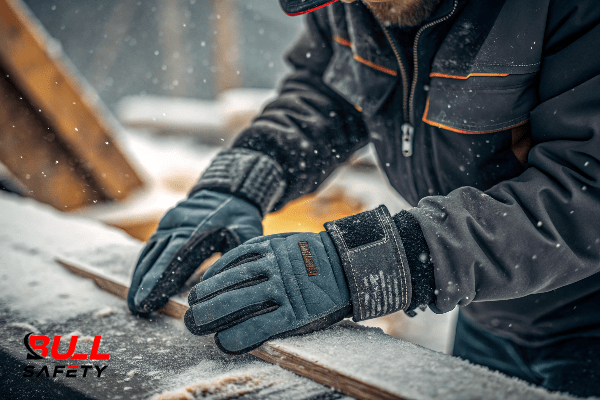
Superior Warmth Winter Work Gloves.
After more than a decade of manufacturing work gloves here at BullSafety, I’ve learned a lot. I’ve read countless guides, like the one that inspired this post, and they confirm what our daily challenges teach us. Creating a truly great winter glove is an engineering puzzle. It’s about finding the perfect balance between warmth, water resistance, and the dexterity a worker needs to do their job right. It’s a trade-off we navigate every single day. This post will break down exactly how that balance is achieved.
What key materials and technologies are behind water-resistant insulation?
You can’t just stuff a glove with cotton and hope for the best. Choosing the right materials is the first step. The goal is to block cold and moisture from the outside while letting sweat escape.
Modern winter gloves rely on synthetic insulations and advanced shell fabrics3. These materials are engineered to trap heat effectively without absorbing water. This ensures your hands stay warm and dry, even when working in snowy or wet environments, preventing dangerous heat loss and discomfort.
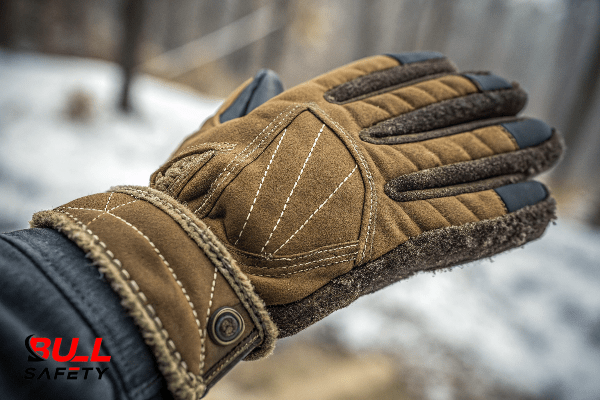
Advanced Insulation Materials for Work Gloves.
In my experience, the materials make all the difference. We work with wholesalers around the globe, and their needs vary. A construction manager in a wet, cold climate has different requirements than someone working in a dry, freezing warehouse. That’s why understanding the raw materials4 is so important. As noted in a guide by Droppe, different materials are suited for different tasks. We spend a lot of time testing new fabrics and insulation types5 to meet these diverse demands. The key is to find a material that provides warmth without being so thick that you can’t pick up a screw. This balance is everything. Here’s a simple breakdown of the common choices.
Insulation Materials
Effective insulation traps air to create a thermal barrier. Thinsulate™ is a popular choice because it provides excellent warmth with less bulk, which improves dexterity. We often recommend it for tasks requiring fine motor skills.
Shell Materials
The outer shell is the first line of defense. Materials like nylon or polyester are common because they are durable and naturally repel water. We often treat these fabrics with a Durable Water Repellent (DWR) coating to enhance their performance in wet conditions.
Material Properties Overview
| Material | Best For | Key Features |
|---|---|---|
| Leather | Heavy-duty tasks, construction | Durable, abrasion-resistant, naturally insulating. |
| Synthetics (Nylon, Polyester) | Wet conditions, logistics | Lightweight, water-resistant, quick-drying. |
| Knitted Fabrics | Precision tasks, light work | Flexible, offers good dexterity and breathability. |
How does multi-layer construction provide maximum warmth?
A single layer can’t do it all. You need a system where each layer has a specific job. This teamwork approach is what makes a winter glove truly effective against the elements.
A multi-layer design creates a high-performance system for your hands. It typically includes a durable, water-resistant outer shell, a middle insulation layer to trap heat, and a soft inner liner to wick away moisture. This construction ensures you stay warm, dry, and comfortable.
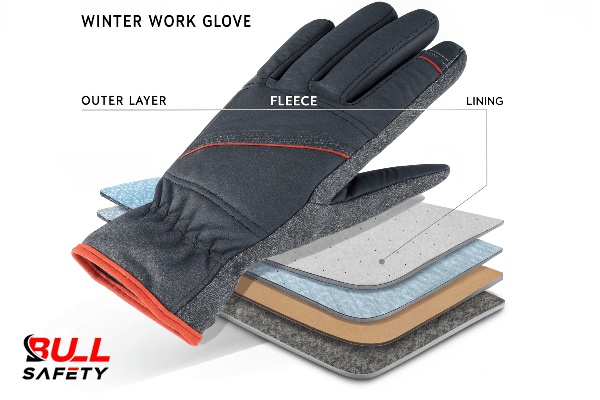
Multi-Layer Glove Construction.
I remember one of our early projects. We were developing a new glove for a partner who worked in cold storage facilities. The initial prototype was warm, but after an hour, the inside was damp with sweat, making the user’s hands cold. We realized our liner wasn’t effective. It took weeks of re-engineering the layers to get it right. This taught me that the layers can’t just be stacked; they have to work together. A high-performance glove6 is more than the sum of its parts. It’s a fully integrated system7 designed for a specific environment.
The Outer Shell: Your First Defense
This layer is built for toughness. It has to resist wind, water, and abrasions from the work environment. We use materials like tightly woven nylon8 and then add coatings or membranes to boost its weather-blocking power. This is the layer that takes all the punishment.
The Middle Layer: The Engine of Warmth
This is where the insulation sits. Its only job is to trap your body heat and stop the cold from getting in. The key here is efficiency—maximum warmth with minimum bulk9. If this layer is too thick, you lose the ability to handle tools effectively. Materials like fleece or synthetic down are common here.
The Inner Liner: Comfort and Moisture Management
This is the layer that touches your skin. It needs to be soft and comfortable, but more importantly, it has to manage sweat. We use moisture-wicking materials10 that pull sweat away from your skin and move it toward the outer layers, where it can evaporate. A dry hand is a warm hand.
Waterproofing vs. Water-Resistance: What is the difference?
People often use these terms interchangeably, but they mean very different things. For a purchasing manager, choosing the wrong one can lead to unhappy workers and wasted money.
Water-resistant gloves can handle light rain or snow, causing water to bead up and roll off. Waterproof gloves, however, provide a complete barrier against moisture, thanks to a built-in membrane. They are designed for prolonged exposure to wet conditions or submersion.
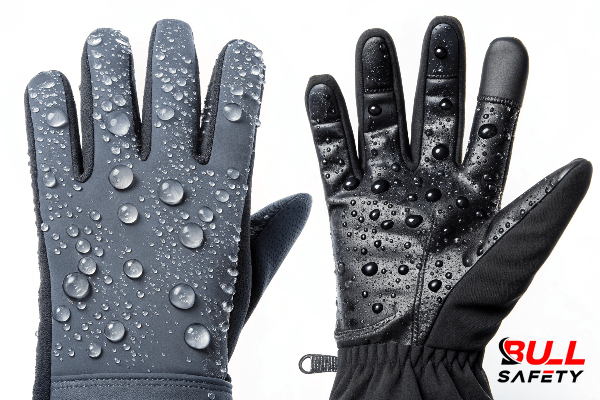
Waterproof vs Water-Resistant Gloves.
This is one of the first questions I ask our wholesale partners: "Do your customers need water-resistant or fully waterproof gloves?" The answer changes everything about the glove’s design and cost. For example, a landscaper who might get caught in a quick shower needs something different from a commercial fisher. We manufacture both types. For water resistance, a DWR coating11 on the shell is often enough. For full waterproofing, we have to build a waterproof, breathable membrane12 into the glove’s construction. This adds complexity and cost, but for certain jobs, it’s non-negotiable. It’s crucial to match the glove’s protection level to the actual work environment.
Water-Resistant Gloves
Think of these as your go-to for general winter work where you might encounter some moisture.
- Technology: Typically relies on a tightly woven outer fabric and a Durable Water Repellent (DWR) coating.
- Best Use: Light rain, snow flurries, and damp surfaces.
- Limitation: The coating can wear off over time and will fail under heavy rain or submersion.
Waterproof Gloves
These are for jobs where your hands are consistently exposed to water.
- Technology: Includes a dedicated waterproof membrane (like a bootie) inserted between the outer shell and the insulation. This membrane has microscopic pores that are too small for water droplets to enter but large enough for water vapor (sweat) to escape.
- Best Use: Heavy rain, slush, and jobs involving liquids.
- Limitation: Can sometimes be less breathable than water-resistant options, which is why a quality membrane is so important.
What essential features should you look for in professional winter work gloves?
Beyond warmth and water resistance, other features separate a decent glove from a professional one. It’s the small details that enhance safety, durability, and usability on the job site.
Look for a reinforced palm for durability, a design that allows good dexterity, and a secure cuff to seal out cold and debris. The grip is also critical; it should match the work environment, whether it’s wet, dry, or oily.
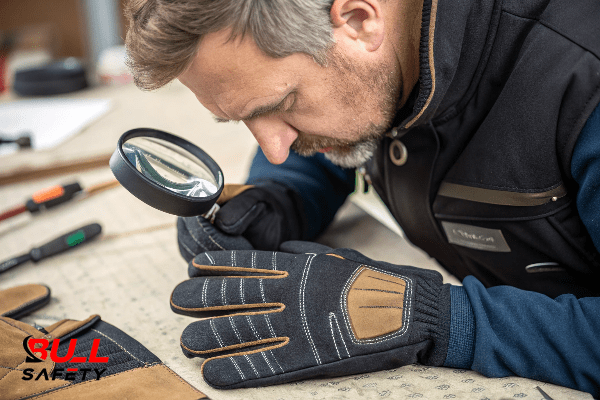
Essential Features of Professional Work Gloves.
My wholesale partners are very specific about these features. They represent professionals who depend on their gear, so there’s no room for error. A glove that wears out in a week or doesn’t allow a worker to feel their tools is a failed product. That’s why we obsess over things like seam strength13 and grip patterns. For instance, as we’ve detailed on our own blog, a sandy nitrile coating14 offers a far better grip in oily conditions than a smooth one. These aren’t just selling points; they are critical safety features that we have spent years perfecting based on direct feedback from the people who use our gloves every day.
Enhanced Grip
The grip must match the job.
- Sandy Nitrile a: Excellent for oily or wet conditions.
- Foam Nitrile: Great for dexterity and absorbing oil on surfaces.
- Silicone Patterns: Often added to palms and fingers for extra traction when handling tools.
Durability and Reinforcement
A work glove needs to be tough. We look at reinforcing key wear areas, like the palm, fingertips, and the saddle between the thumb and index finger. Double-stitching and using tough materials like leather in these spots can dramatically extend the life of a glove.
Dexterity and Sizing
A warm glove is useless if you have to take it off to do your work. We use pre-curved finger designs that mimic the natural resting shape of the hand. This reduces fatigue and improves dexterity. Proper sizing is also crucial; a glove that’s too big is clumsy, and one that’s too small can restrict blood flow, making your hands colder.
Conclusion
Creating effective winter work gloves is a science. It relies on a balanced system of advanced materials, thoughtful construction, and features tailored to the job. It’s a puzzle we’ve proudly been solving for over a decade.
-
Explore this link to discover top-rated winter work gloves that offer warmth and protection for your hands. ↩
-
Learn about thermal insulation and its importance in keeping your hands warm during cold weather. ↩
-
Discover the role of advanced shell fabrics in keeping your hands dry and warm in harsh winter conditions. ↩
-
Understanding raw materials is crucial for selecting the right products for various construction needs. ↩
-
Exploring this topic can help you choose the most effective materials for your specific climate and project. ↩
-
Explore this link to understand the essential features that make a glove high-performance, especially in cold environments. ↩
-
Discover how an integrated system enhances product performance, ensuring all components work harmoniously for optimal results. ↩
-
Learn about the benefits of tightly woven nylon in outdoor apparel, including its strength and resistance to wear. ↩
-
Explore techniques to stay warm without the bulk, optimizing your comfort and mobility. ↩
-
Understanding moisture-wicking materials can enhance your comfort and performance in various activities. ↩
-
Learn how DWR coating enhances water resistance in gloves, helping you choose the right protection for your work environment or outdoor activities. ↩
-
Exploring this technology will give you insights into how it enhances comfort and functionality in various conditions. ↩
-
Learn about the significance of seam strength in work gloves and how it impacts durability and safety for users. ↩
-
Discover how sandy nitrile coating enhances grip and safety in gloves, crucial for professionals relying on their gear. ↩



